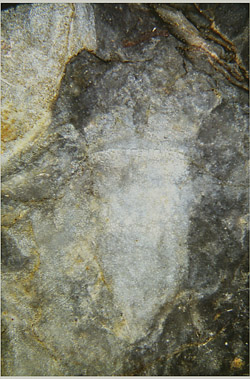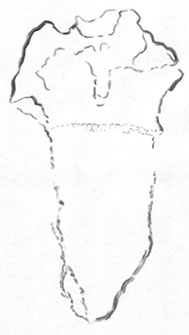A jellyfish that would not fit in
 Usually,
accumulated knowledge on fossil and extant species is favourable in the
attempt
to discover something new on surfaces or cut faces of fossiliferous
cherts.
The present case is different as the unique object that looks like a
polyp near the circular
jellyfish imprint has been spotted with a mere curious look at the
sample
(Fig.1) but
people with expert knowledge of jellyfish did not find it even though
they had
been told it was there. This makes it all the more interesting.
Usually,
accumulated knowledge on fossil and extant species is favourable in the
attempt
to discover something new on surfaces or cut faces of fossiliferous
cherts.
The present case is different as the unique object that looks like a
polyp near the circular
jellyfish imprint has been spotted with a mere curious look at the
sample
(Fig.1) but
people with expert knowledge of jellyfish did not find it even though
they had
been told it was there. This makes it all the more interesting.
Fig.1: Fracture face of laminated chert of limnic origin, probably
Lower Permian, from the Nobitz gravel pit, Saxony, apparently with
polyp and medusa stages of jellyfish.
Width of the image 6cm.
Compressed medusae of similar size have been found in similar sediments
several times before.
Limnic
medusae preserved as imprints in fine-grained Permian sediments in
Europe are
usually regarded as freshwater hydromedusae of the species Medusina limnica
[1].
It may be mentioned here that jellyfish are subdivided into Hydrozoa,
Cubozoa, and Scyphozoa, and that their life cycle usually comprises
polyp and
medusa stages. The way of transition from polyp to medusa is a
distinctive feature of the clades. With the polyp stage missing in the
hitherto available samples, Medusina
has been assigned to the Hydrozoa. The polyp in the present
sample is faintly seen upside down near the lower edge of
Fig.1, enlarged and upright in Fig.2,


Fig.2 (left): Detail of Fig.1
suggesting an interpretation as a polyp prepared to shed its
top which
is to become a medusa.
Height of the polyp 11mm.
This polyp with its apparent abscission layer of special cells, seen as
a thin horizontal line in
Fig.2, allows the fossil to be assigned to one of the jellyfish
clades. Cubozoan polyps turn into their medusa as a whole, which
would not be compatible with Fig.2. Hydrozoan polyps produce medusae by
budding,
which would not fit either. Only Scyphozoan polyps form abscission
layers facilitating the consecutive release of top regions which turn
into medusae. Hence, one is tempted to declare the present
medusa with polyp a Scyphozoan. However, all extant Scyphozoans are sea
jellyfish but this fossil one is silicified in peat-like sediment with
terrestrial plant fragments, including parts of
parallel-veined leaves of trees. The difficulty could possibly be
overcome with the assumption that it was a salt water lake where the
marine species had lived and the terrestrial plant litter had got
washed into.
The
dissolved silica for chert formation had probably been provided by the
wide-spread volcanism in Saxony in the Lower Rotliegend [3].
If the present fossil is really a scyphomedusa,
it
is the first one found in a terrestrial environment [to be revised, see
Annotation]. Considering that
salt water lakes had been around in Saxony in those times [4], this
could well be the case.
The interpretation of this fossil as a Scyphozoan raises the question
whether or not some or all of the fossil medusae called Medusina
and interpreted as Hydrozoans are really Scyphozoans. (It is worth
mentioning that the term "hydromedusa" in connection
with Medusina
is avoided in [2]. ).
This roughly 4-sided fragment of
a chert layer, 0.85kg, with glossy black side faces as often seen on
cherts from Nobitz, had been collected in 2007 by Sieglinde Weiss
for its pale circular spots. (For another unique find from the Nobitz
gravel pit see Fossil
Wood News 10.)
Closer inspection in 2008 revealed the
thin abscission line in Fig.2 which meant the
discovery of the polyp. Since an abscission line would not fit into the
established concept of Permian hydromedusae,
palaeontologists proposed that the line might be a mere crack. This is
contradicted by the observation that a (hardly visible) crack
approaches the abscission line on the right and does not run along but
proceeds as if the line were not there. Hence, there is no indication
that the thin line across the
polyp might be a former crack.
It is
recommended to closely inspect all samples with alleged hydromedusae in
order to possibly spot more of the elusive polyps.
H.-J. Weiss 2017
Annotation Nov. 2017:
The
elongate something in Fig.2 is shaped like a polyp and
has got an abscission line like a polyp about to shed a medusa, hence
most probably it is really a polyp. Several years ago, J.
Schneider, after thorough inspection of this sample, had thought the
circles in Fig.1 to be "fructifications,
probably Cardiocarpus", and the polyp a mere streak of silica. This
must be mentioned now that he is propagating his interpretations with
an emotionally fraught language,
elevating them to facts, and spreading them among
paleontologists by serial e-mail
(24.10.2017, in German): Shying any contact, he calls the medusa
and polyp interpretation utter nonsense, which gives the reason to
closely inspect the sample once more.
Round
fructifications are smooth
but the round spots seen here are irregularly
sculptured, perhaps owing to the deranged central parts of the medusa.
J. Schneider's interpretation of Fig.2 as a streak of silica can be
understood as the result of poor mental image processing, perhaps in
combination with a reluctance to see polyps of scyphomedusae since these
would raise doubts concerning his assumption of Permian
jellyfish Medusina
being a hydromedusa [5]. The information of Medusina having
been regarded by others as a scyphomedusa for more than a century [6]
has become accessible just now. It has to be found out whether the related polyp had been seen then.
Since it appears that J. Schneider scoffs
at fossil evidence which contradicts his views, he cannot be taken
seriously.
[1] D. Schüppel:
Abdrücke von Hydromedusen aus dem Unterrotliegenden des Erzgebirgischen
Beckens,
Freiberger Forschungshefte C395 (1984), 38-46.
[2] H. Kozur:
die Verbreitung der limnischen Meduse Medusina limnica
Müller
1978 im Rotliegenden Mitteleuropas.
Paläontolog. Z. 58(1984), 41-50.
[3] H. Walter:
Das Rotliegend der Nordwestsächsischen Senke. Veröff.
Naturkundemuseum Chemnitz 29(2006), 157-176.
[4] J. Schneider,
U. Gebhardt: Dasycladaceen und andere "marine" Algen in
lacustrischen Kalken des Unter-Perm (Assel) im
intermontanen Döhlen-Becken.
Freiberger Forschungshefte C445
(1992), 66-88.
[5] J.W.
Schneider
et al.: CPC-2014 Field Meeting Excursion Guide, Wiss. Mitt. Inst. f.
Geologie 46, Freiberg 2014.
[6] S.
Stamberg, J. Sajiz: Carboniferous and Permian faunas and
their occurrence in the limnic basins of the Czekh Republic (2008), 39.
Museum of
Eastern Bohemia, Hradec Kralove.
|
 |
 16 16 |

 16
16 Usually,
accumulated knowledge on fossil and extant species is favourable in the
attempt
to discover something new on surfaces or cut faces of fossiliferous
cherts.
The present case is different as the unique object that looks like a
polyp near the circular
jellyfish imprint has been spotted with a mere curious look at the
sample
(Fig.1) but
people with expert knowledge of jellyfish did not find it even though
they had
been told it was there. This makes it all the more interesting.
Usually,
accumulated knowledge on fossil and extant species is favourable in the
attempt
to discover something new on surfaces or cut faces of fossiliferous
cherts.
The present case is different as the unique object that looks like a
polyp near the circular
jellyfish imprint has been spotted with a mere curious look at the
sample
(Fig.1) but
people with expert knowledge of jellyfish did not find it even though
they had
been told it was there. This makes it all the more interesting. 


 16
16